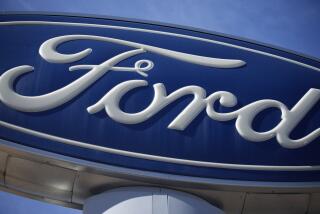Average fuel economy of new autos at new record; progress may stall

New vehicles reached record-high fuel economy in 2013, according to a new Environmental Protection Agency report.
The federal agency said Wednesday that 2013 model year vehicles achieved an average of 24.1 miles per gallon — up 0.5 mpg from the previous year and nearly 5 mpg since 2004.
Fuel economy has now increased in eight of the last nine years, the report said. Meanwhile, average carbon-dioxide emissions sank to a record low of 369 grams per mile in 2013, a 2% decrease from the prior year.
“We are thrilled to see that manufacturers continue to innovate and are bringing technologies to improve fuel economy online even faster than anticipated,” said EPA Administrator Gina McCarthy.
McCarthy attributed the efficiency gains to adoption of technologies including direct-injection engines, turbochargers and advanced transmissions.
But automakers might find it difficult to sustain the progress. Preliminary estimates for this year in the study indicate that the improvements may stall in 2014. It will take time for new technologies to achieve more widespread adoption.
Some environmental groups said the report highlights real achievement in reducing fuel consumption and emissions.
Federal fuel economy standards are “creating tangible benefits for millions of drivers,” said Don Anair, deputy director of the Union of Concerned Scientists’ Clean Vehicles Program.
He said the figures mean that Americans use 1.7 million fewer gallons of gasoline, or 40,000 barrels of oil, daily. An average 2013 model year vehicle will save drivers about $86 a year over the average 2010 model.
But there’s work ahead, Anair noted. The federal standard will require auto fleets to achieve an average real-world mileage of about 26 mpg by 2016.
Among the automakers, Mazda vehicles sold in the U.S. had the highest average fuel economy — 28.1 mpg — and lowest greenhouse-gas emissions, at 316 grams per mile, the report said. Nissan, meanwhile, achieved the greatest improvement in average fuel economy, jumping to 26.2 mpg from 24.1 mpg in 2012.
Chrysler posted the lowest fuel economy, an average of just 20.9 mpg last year, probably because of its heavy sales of trucks and SUVs. Ford and GM averaged 22.2 and 22.0 mpg, respectively.
Ford and Toyota were the only two automakers that failed to increase their average fuel economy last year.
Despite the 2013 gains, Dan Becker, director of the Safe Climate Campaign, said the auto industry is not moving quickly enough to meet federal fuel economy and pollution reduction targets for 2025. Preliminary projections by the EPA indicate that fuel economy will barely budge this year, to just 24.2 mpg.
“The Environmental Protection Agency’s fuel efficiency Trends Report demonstrates that the automakers are thumbing their collective noses at the Obama administration’s mileage and emissions rules,” Becker said.
Under a different measurement — generated in a federal test laboratory — auto companies must reach an average fleet fuel economy of 54.5 miles per gallon in 2025. That laboratory target translates to about 40 miles per gallon in actual driving, according to EPA officials.
In real world terms, fuel economy will have to increase by more than one mile per gallon annually through 2025, or by about 67% from the 2013 level, to meet the federal goal. But the preliminary 2014 data indicate that auto industry fuel economy has “flat-lined,” Becker said.
Fuel economy took a big drop last month, according to Michael Sivak, a University of Michigan Transportation Research Institute professor.
Sivak and a team of researchers at the university calculate a sales-weighted average fuel economy for new vehicles sold each month. They reported that the gas mileage of new vehicles sold in the U.S. in September was 25.3 mpg, down from a record high 25.8 mpg in August and the largest drop in nearly three years.
“This large drop likely reflects the increased sales of light trucks and SUVs, and the reduced demand for fuel efficient vehicles of all types because of the falling gas prices,” Sivak said.
However, the EPA report notes that much fuel saving technology is just beginning to appear on new models.
More new vehicles feature advanced, fuel efficient transmissions. But those technologies will still reach only 30% of the market this year.
Another new technology, which shuts off the vehicle at stoplights, will reach only 5% of the market this year. And new weight-saving technologies, such as lightweight body panels made of aluminum or carbon fiber, are only now starting to reach consumers.
“We are going to see more start/stop technology and greater use of aluminum, such as in the Ford F-150 truck that is coming out,” said Chris Grundler, the EPA’s director of the office of transportation and air quality.
Still, the EPA report gives a clear indication that automakers are working to increase fuel economy and meet federal regulations, she said. Grundler noted that the number of passenger car models achieving at least 30 mpg has more than tripled since 2009.
“We are seeing not only advances in passenger vehicles but in trucks as well,” McCarthy said. “We have had a great year, and we believe these trends will continue.”
Twitter: @latimesjerry
More to Read
Inside the business of entertainment
The Wide Shot brings you news, analysis and insights on everything from streaming wars to production — and what it all means for the future.
You may occasionally receive promotional content from the Los Angeles Times.











